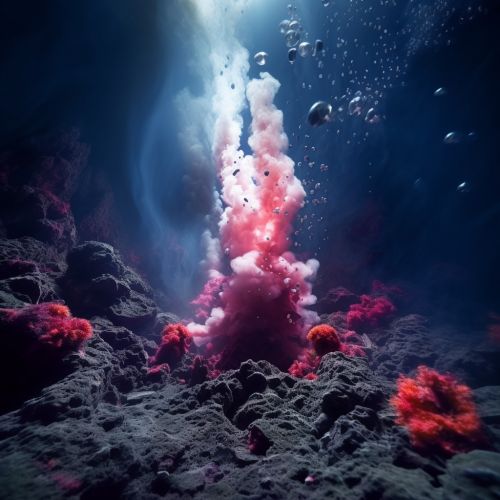The Ecology of Deep-Sea Hydrothermal Vents
Introduction
Deep-sea hydrothermal vents are unique ecosystems that exist in the deep ocean, typically at depths of over 2,000 meters. These systems are characterized by the emission of geothermally heated water, which is rich in chemicals such as hydrogen sulfide, methane, and various metals. The vents provide a unique environment that supports a diverse array of organisms, many of which are not found anywhere else on Earth. This article will explore the ecology of these fascinating systems, including the physical and chemical environment, the organisms that inhabit them, and the ecological processes that occur.


Physical and Chemical Environment
Deep-sea hydrothermal vents are located along mid-ocean ridges, where tectonic plates are spreading apart. The spreading process allows magma to rise from the Earth's mantle, heating the overlying seawater and causing it to circulate through the oceanic crust. This heated water becomes enriched with various chemicals as it interacts with the rocks, and is then expelled back into the ocean at the hydrothermal vents. The temperature of the vent fluid can reach up to 400 degrees Celsius, although it rapidly cools upon mixing with the surrounding seawater.
The chemical composition of the vent fluid is highly variable, depending on factors such as the geology of the vent site and the depth of circulation within the crust. However, it is typically rich in reduced chemicals such as hydrogen sulfide, methane, and various metals. These chemicals provide the energy source for the unique chemosynthetic organisms that inhabit the vents.
Biological Communities
The biological communities at deep-sea hydrothermal vents are among the most unique and diverse on Earth. Unlike most other ecosystems, which rely on sunlight as their primary energy source, vent communities are based on chemosynthesis. This is a process in which certain bacteria and archaea use the chemicals in the vent fluid as an energy source to produce organic matter. These chemosynthetic microbes form the base of the vent food web, and are consumed by a variety of organisms including worms, clams, crabs, and fish.
Many of the organisms at hydrothermal vents have evolved unique adaptations to survive in this extreme environment. For example, the Riftia pachyptila, also known as the giant tube worm, has a symbiotic relationship with chemosynthetic bacteria, which live inside a specialized organ in the worm's body. The bacteria provide the worm with nutrients, while the worm provides the bacteria with access to the vent fluid.
Ecological Processes
The ecological processes at deep-sea hydrothermal vents are largely driven by the availability of chemical energy from the vent fluid. The chemosynthetic microbes at the base of the food web convert this energy into organic matter, which is then transferred up the food chain through predation and scavenging. This process is known as chemotrophic primary production, and it is the primary means of energy flow in vent ecosystems.
The spatial distribution of organisms at hydrothermal vents is largely determined by the physical and chemical conditions of the vent fluid. For example, organisms that are adapted to high temperatures and high concentrations of chemicals, such as certain types of bacteria and archaea, are typically found close to the vent orifice. In contrast, organisms that are less tolerant of these extreme conditions, such as certain types of worms and clams, are typically found further away from the vent.
Conservation and Threats
Deep-sea hydrothermal vents are vulnerable to a variety of threats, including deep-sea mining, climate change, and pollution. Deep-sea mining, in particular, poses a significant threat to vent ecosystems, as these areas are rich in valuable minerals such as copper, gold, and rare earth elements. However, mining activities can cause significant damage to the vent habitat and its associated biological communities.
Conservation of hydrothermal vents is challenging due to their remote location and the lack of knowledge about these ecosystems. However, efforts are being made to protect these unique habitats through the establishment of marine protected areas and the development of sustainable mining practices.
